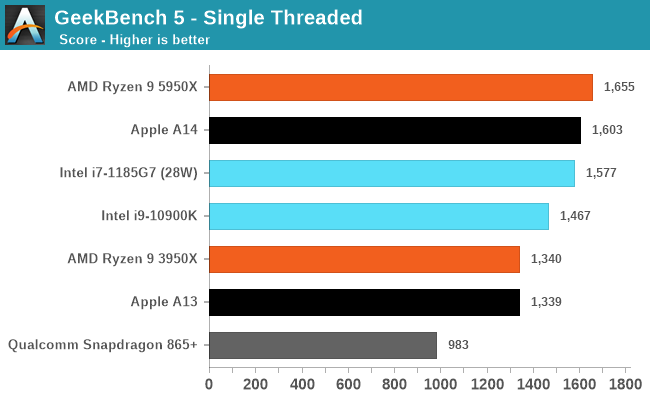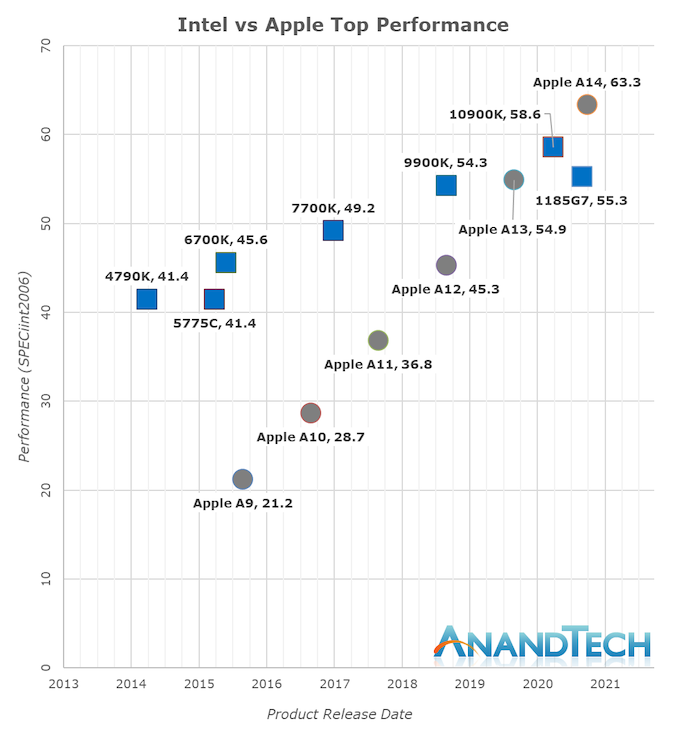Apple Announces The Apple Silicon M1: Ditching x86 - What to Expect, Based on A14
by Andrei Frumusanu on November 10, 2020 3:00 PM EST- Posted in
- Apple
- Apple A14
- Apple Silicon
- Apple M1
From Mobile to Mac: What to Expect?
To date, our performance comparisons for Apple’s chipsets have always been in the context of iPhone reviews, with the juxtaposition to x86 designs being a rather small footnote within the context of the articles. Today’s Apple Silicon launch event completely changes the narrative of what we portray in terms of performance, setting aside the typical apples vs oranges comparisons people usually argument with.
We currently do not have Apple Silicon devices and likely won’t get our hands on them for another few weeks, but we do have the A14, and expect the new Mac chips to be strongly based on the microarchitecture we’re seeing employed in the iPhone designs. Of course, we’re still comparing a phone chip versus a high-end laptop and even a high-end desktop chip, but given the performance numbers, that’s also exactly the point we’re trying to make here, setting the stage as the bare minimum of what Apple could achieve with their new Apple Silicon Mac chips.

The performance numbers of the A14 on this chart is relatively mind-boggling. If I were to release this data with the label of the A14 hidden, one would guess that the data-points came from some other x86 SKU from either AMD or Intel. The fact that the A14 currently competes with the very best top-performance designs that the x86 vendors have on the market today is just an astonishing feat.
Looking into the detailed scores, what again amazes me is the fact that the A14 not only keeps up, but actually beats both these competitors in memory-latency sensitive workloads such as 429.mcf and 471.omnetpp, even though they either have the same memory (i7-1185G7 with LPDDR4X-4266), or desktop-grade memory (5950X with DDR-3200).
Again, disregard the 456.hmmer score advantage of the A14, that’s majorly due to compiler discrepancies, subtract 33% for a more apt comparison figure.

Even in SPECfp which is even more dominated by memory heavy workloads, the A14 not only keeps up, but generally beats the Intel CPU design more often than not. AMD also wouldn’t be looking good if not for the recently released Zen3 design.

In the overall SPEC2006 chart, the A14 is performing absolutely fantastic, taking the lead in absolute performance only falling short of AMD’s recent Ryzen 5000 series.
The fact that Apple is able to achieve this in a total device power consumption of 5W including the SoC, DRAM, and regulators, versus +21W (1185G7) and 49W (5950X) package power figures, without DRAM or regulation, is absolutely mind-blowing.

There’s been a lot of criticism about more common benchmark suites such as GeekBench, but frankly I've found these concerns or arguments to be quite unfounded. The only factual differences between workloads in SPEC and workloads in GB5 is that the latter has less outlier tests which are memory-heavy, meaning it’s more of a CPU benchmark whereas SPEC has more tendency towards CPU+DRAM.
The fact that Apple does well in both workloads is evidence that they have an extremely well-balanced microarchitecture, and that Apple Silicon will be able to scale up to “desktop workloads” in terms of performance without much issue.
Where the Performance Trajectory Finally Intersects
During the release of the A7, people were pretty dismissive of the fact that Apple had called their microarchitecture a desktop-class design. People were also very dismissive of us calling the A11 and A12 reaching near desktop level performance figures a few years back, and today marks an important moment in time for the industry as Apple’s A14 now clearly is able to showcase performance that’s beyond the best that Intel can offer. It’s been a performance trajectory that’s been steadily executing and progressing for years:
Whilst in the past 5 years Intel has managed to increase their best single-thread performance by about 28%, Apple has managed to improve their designs by 198%, or 2.98x (let’s call it 3x) the performance of the Apple A9 of late 2015.
Apple’s performance trajectory and unquestioned execution over these years is what has made Apple Silicon a reality today. Anybody looking at the absurdness of that graph will realise that there simply was no other choice but for Apple to ditch Intel and x86 in favour of their own in-house microarchitecture – staying par for the course would have meant stagnation and worse consumer products.
Today’s announcements only covered Apple’s laptop-class Apple Silicon, whilst we don’t know the details at time of writing as to what Apple will be presenting, Apple’s enormous power efficiency advantage means that the new chip will be able to offer either vastly increased battery life, and/or, vastly increased performance, compared to the current Intel MacBook line-up.
Apple has claimed that they will completely transition their whole consumer line-up to Apple Silicon within two years, which is an indicator that we’ll be seeing a high-TDP many-core design to power a future Mac Pro. If the company is able to continue on their current performance trajectory, it will look extremely impressive.











644 Comments
View All Comments
Spunjji - Friday, November 13, 2020 - link
@vais - Perhaps I should have clarified that my comment was indeed regarding the single-core results? But I sort-of assumed anybody reading it would have *read the article* and thus was aware of that context. 🤦♂️We won't get multi-core data until later, for sure, but your attempt to pretend that we therefore have *no idea* what's coming is mere sophistry. I'd advise you adjust your expectations accordingly, as you've already indicated a level of certainty in the outcome (mY i5 WiLl BeAt It) that you are simultaneously arguing nobody else is entitled to. That cognitive dissonance has been noted.
vais - Friday, November 13, 2020 - link
I had missed Graviton, thanks for the link!It seems very interesting and is a much more fair comparison as all 3 CPUs have similar TDPs. AMD are still some way from Zen3 based Epyc CPUs, but even if they have better performance than Graviton 2, they still could be far behind in the performance/$.
As for M1 all I'm saying is that comparing it to other laptop CPUs with similar TDP (of course higher too since it is more efficient) is one thing. But comparing it to the latest desktop CPUs is another story and reality might not reflect the synthetic benchmarks that well.
If say M2 was positioned for the Mac Pro at 50-60-70W TDP, then comparing it to 5950X would make sense and it really could have better performance - that is all.
misan - Thursday, November 12, 2020 - link
Dedicated silicon for compiling code? Or for doing scientific computation? Or for traversing linked lists? SPEC benchmark suite is extensively documented and the individual benchmark behavior is understood. This is all plain C code that targets the CPU.I understand that it might be hard to accept it, but the simple fact is that Apple has made a substantially better chip. They can do much more work per clock than anything else on general-purpose code, which allows them to be fast without needing very high clocks.
Spunjji - Thursday, November 12, 2020 - link
@Coldfriction - the "dedicated silicon" you refer to played no part in any of the tests in this article.Coldfriction - Thursday, November 12, 2020 - link
You mean all of the memory on package with the CPU doesn't make a difference? That's the "dedicated silicon" sort of thing I'm talking about. How fast was the SNES CPU was 3.58 Mhz. It took a massively more powerful intel, amd, or cyrix chip to do what the SNES could do. MASSIVELY more powerful. What Apple is doing here is making a console PC. The performance isn't all derived from their CPU cores independent of the rest of the system. Everything is tightly integrated with no flexibility on the users end. The Cell architecture boasted similar stuff back in the day. Yes, Apple has a strong ARM CPU here, but it's the tight integration that makes it so strong, not the core itself. There's a reason the memory is in the package and non-upgradable. The functions tested in this article may drastically favor the cache system of the M1, but once you go outside of that, you lose a lot.It's ALWAYS been the case that custom built systems have outperformed generic computing devices.
This article doesn't test very many things. It certainly doesn't test demanding workloads that saturate much of the systems capabilities.
I owned Amigas back in the day. I had access to a variety of computing devices. The IBM compatible PCs were the ugliest slowest machines around, but they succeeded where everyone else's prettier systems failed. Why? Compatibility and ability to swap the software and hardware from different vendors around. They became cheap and maintained by a variety of people due to that. The Apple Lisa I had as a kid blew away my first 386, but then Apple still nearly went bankrupt a decade later.
Custom build design is great for a very short term solution, but Apple's leash of leather is being swapped out for a leash of steel chain with this move.
daveedvdv - Thursday, November 12, 2020 - link
> You mean all of the memory on package with the CPU doesn't make a difference? That's the "dedicated silicon" sort of thing I'm talking about.That's quite the stretch. What exactly is that memory dedicated to? It's not like other manufacturers cannot package main memory with their chips either. It sounds like you're grasping at straws because you don't like the news.
Spunjji - Friday, November 13, 2020 - link
@daveedvdv - I think you nailed it there. There's a lot of that going on in these comments.Hell, I don't *like* the news. I'm a Windows guy and I don't buy Apple devices; if it turns out they'll have exclusive access to some of the best-performing mobile silicon on the planet it'll be kind of a bitch. But it is what it is.
daveedvdv - Friday, November 13, 2020 - link
@Spunjji:Thanks. And, FWIW, while I'm an Apple eco-system person, I'm under no illusion that others will be able to match the achievement relatively soon. There are lots of players in the ARM ISA world, and they each have some serious talent working for them.
Spunjji - Friday, November 13, 2020 - link
@coldfriction - On-package memory isn't "custom silicon". Either you're talking about "dedicated silicon" - i.e. the accelerators that Apple's chip has and others don't - or you're talking about shared caches and memory interfaces that every other chip out there has / can have.The SNES CPU thing is a weird flex - everybody knows that emulation requires more resources than the original system, but the SNES CPU wasn't remarkable in any way. A better example would have been the Amiga's video controllers, but then you'd run straight into what I pointed out, which is that such a comparison is irrelevant to what was actually tested in this article - the CPU architecture (including caches and, in some tests, memory performance).
You're right that it doesn't test demanding workloads or the entire system - that wasn't the remit of the article. We'll see that stuff when they have actual M1-based systems to test; running those tests on A14 in an iPhone would be worse than useless for estimating M1 performance.
magreen - Sunday, November 15, 2020 - link
Keep it up, Spunjji! Thanks for injecting rational discourse into these comments. I have no horse in this race, but I recognize measured statements and rational arguments based on evidence when I see them.